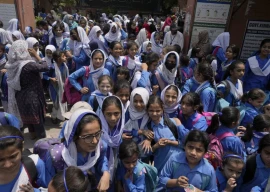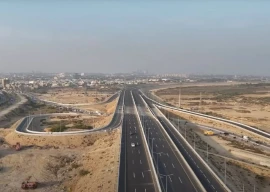
The figure, 4.5°C, means the sea level will rise 15-20 per cent which will submerge some cities (40 per cent of the world’s population lives within 60 miles of a large body of water) and create few new coastal zones, cyclones will wreak havoc on low-latitude regions, droughts and aridity will plague tropical and subtropical areas, coral reef systems will be irreversibly lost, and water scarcity will lead to scenarios that, even in their best case, are catastrophic.
Pakistan’s economy runs on agriculture. Agriculture is where a fourth of your GDP, where half your employed labour force, and your largest source of foreign exchange earnings come from. About 90% of your agricultural production comes from the Indus Basin Irrigation System (IBIS). The IBIS also provides you with a supply of water, energy production capabilities (thermal and hydro), and manufacturing/industrial processes. The IBIS is very large and incredibly wasteful (30% irrigation efficiency). This is what we know about it. What we do not know about the IBIS is where 60% of its water flows originate from, the process of this water flow, the extent of the impact of climate change will have on its hydrological regime, or, most importantly, what we do not know.
Here are some more things we know: Pakistanis in urban areas use 120 litres of water per capita. Pakistanis in rural areas use 45 litres. By 2050, we can expect 3 things: a 17.5% increase in people shifting over to urban areas, the temperature increasing, and the population massively expanding. A temperature increase of 3°C will lead to an increased requirement of water (6% by 2025, 12-15% by 2050) for the agricultural industry (this is the industry your economy depends on in case you forgot). All of this leads to a very bad equation: more demand for water and less supply of it. History tells us this is the point where people will start to get violent. Deliver us from probable precedents.
Projections that look 20-30 years ahead tell us our livestock production will drop 30% along with 20-25% of our cultivable land. But let’s ignore a scenario so far off. Year 2025 is tantalisingly close. It is also a year where we can expect to see Pakistan face severe food shortages that come through issues of water scarcity. This shortage is estimated to be around 70 million tons thanks to the 32% shortfall of water requirements.
You will be reading all this as either boring or terrifying depending on your understanding of basic cause and affect, so let’s change gears and consider the elephant. An African elephant is the largest of all land animals and weighs in at 5 tons. This means we would be lacking in 14 million elephants worth of food. Year 2025 is estimated to be approximately 7 years away from the year 2018 which means this disaster is already knocking on your door. This is, in part, also due to Pakistan’s poor water storage capacity (150 m3 per capita) which sits at 3% of the United States and Australia’s and <7% of China’s. By the much anticipated year, 2025, this will most likely decrease further by 30% thanks to siltation of main reservoirs and climate change reducing the surface water storage capacity.
But wait. There’s so much more. Pakistan comes in at 80 out of 122 with regard to its drinking water quality. Surface and groundwater is plagued with coliform bacteria, toxic metals, and pesticides. Deliver us from microbial pollutants. Deliver us from industrial effluents. Deliver us from agrochemicals. Good news: The WHO has set various drinking water quality parameters. Bad news: these parameters are frequently violated. Spin the wheel. Pick your poison. The first option features an empty glass. The second? Piping hot sludge drink.
This is to say nothing of the waterborne diseases that come-a-clamouring when flooding hits. Deliver us from malaria mosquitoes. Deliver us from cholera calamities. Those are the after effects. The flooding itself also claims lives. As many as 15 died from the most recent spate of heavy monsoon rains in Lahore. Conversely, earlier in the year a heatwave killed 65 people in Karachi. The climate disasters are here and they are going to get much worse very quickly.
The solutions are manifold: perma-raised bed cropping systems, drip and sprinkler irrigation methods, increasing general education on the subject so that the people are made aware of the imminent ugliness of the problem, dam construction (you need a dozen more than just the Kalabagh), better funded academic research conducted on the IBIS instead of another overpass in Lahore, waste prevention, and many more. Here are two that you can make a difference with today: waste less water; donate money to a water charity.
There is violence to the notion that your future holds horrors down the line. Grasping with this is difficult. So let me help further illustrate it. In a decade, Pakistan will be in irreversible trouble as a nation if our current trends continue. In two decades, it will be violently thrashing for water even as its poor resource management means people at its borders are drowning. Rivers will run dry. Crops will turn to dust. Mass migrations will occur. People will die in waves. My advice? Do your part or do not complain when the end times come and you hear the weak, dry bleating of a dying population suffering from short-sightedness. A weakened Pakistan is not a good Pakistan. When the fox hears the rabbit scream he comes running. But not to help.
Published in The Express Tribune, July 12th, 2018.
Like Opinion & Editorial on Facebook, follow @ETOpEd on Twitter to receive all updates on all our daily pieces.

1728296433-0/Nobody-Wants-This-(1)1728296433-0-165x106.webp)


1736715609-0/Untitled-design-(60)1736715609-0-165x106.webp)














COMMENTS (1)
Comments are moderated and generally will be posted if they are on-topic and not abusive.
For more information, please see our Comments FAQ